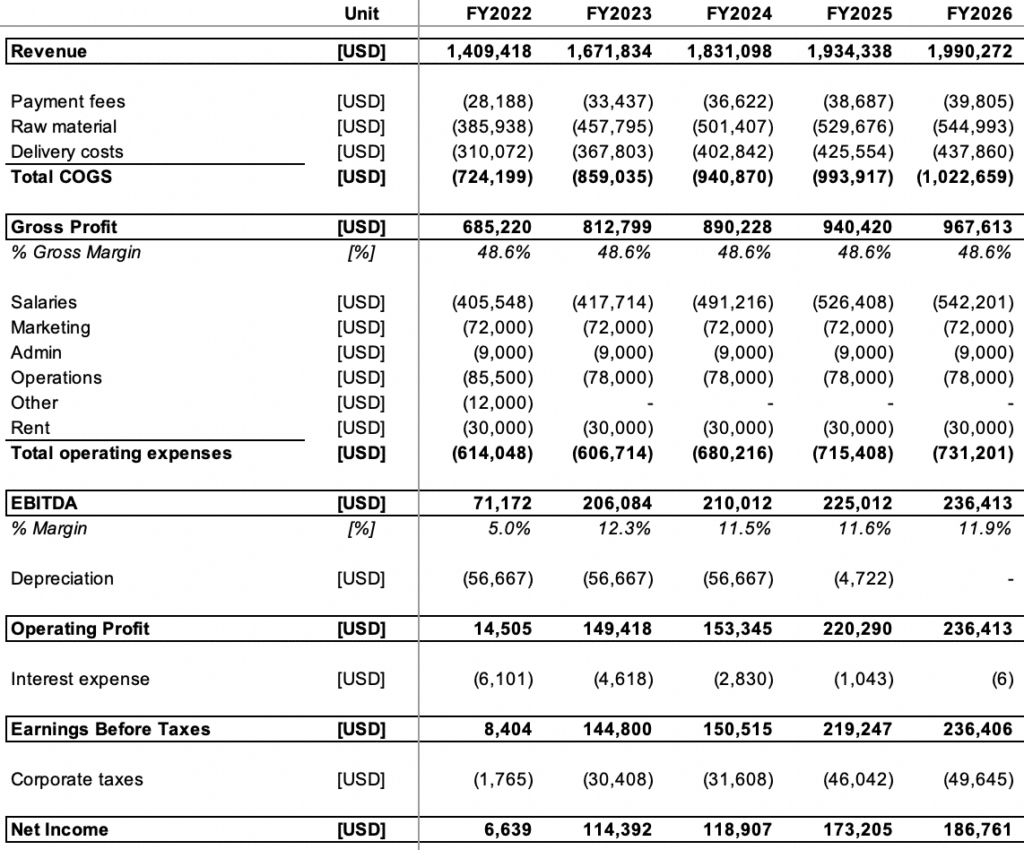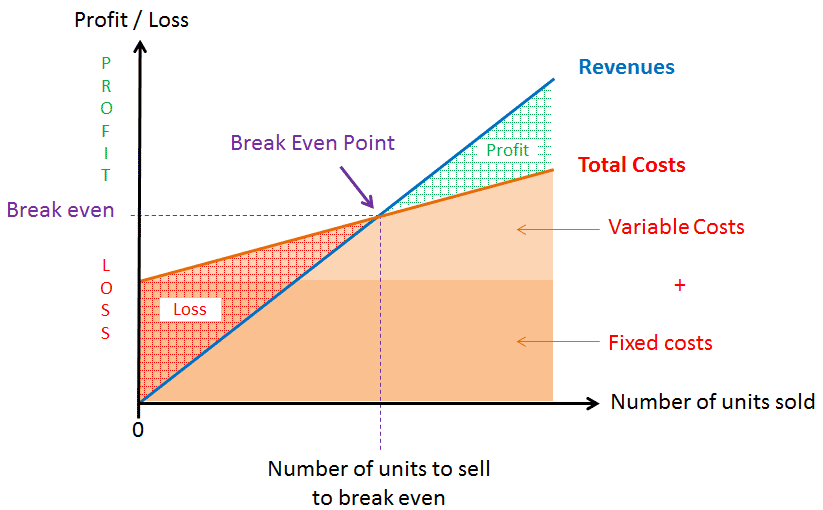How Profitable is a Ghost Kitchen? Profits & Breakeven

If you are planning to start a ghost kitchen, you may want to know how much profits you can make with this business. In other words, you must know how much revenue you must generate to reach break-even and make profits.
Ghost kitchens have become very popular: fuelled by the pandemic and the food delivery industry, the number of ghost kitchens in the US have reached an all-time high of 9,519 in 2021.
Despite the hype, like with restaurants, there is also a lot of competition. So if you’re wondering how much profits you can make with a ghost kitchen, you’d have to consider how much turnover you can generate and the costs you’ll have to pay to run this business. Let’s dive in!
What is the average turnover for a ghost kitchen?
With a $3 billion market size and 9,519 ghost kitchens in the US, the average annual turnover for a ghost kitchen is approximately $315,159.
However, you must understand that this is merely a US average based on market size estimations.
The actual annual turnover for a ghost kitchen varies significantly based on a number of factors such as: the location of your ghost kitchen, its volume (orders), the menu, your distribution strategy (using food delivery apps or not), etc.
What is the average profit margin for a ghost kitchen?
The average profit margin for a ghost kitchen depends on factors like rent, inventory, utilities, labor, maintenance, taxes, etc. On average, Cloud Kitchens reports that the average profit margin is likely around 15% for the industry as a whole.
How much does it cost to run a ghost kitchen?
Operating a ghost kitchen attracts some recurring costs that include:
- COGS: You must purchase raw materials, which happens to the biggest recurring cost
- Food delivery apps commission: You need to pay commissions to the different food delivery apps that you will work with
- Rent or mortgage: You need to pay rent or mortgage installments for the facility where you establish your ghost kitchen
- Employee salaries: Your ghost kitchen will have employees and you must pay salaries to them
- Utilities: You must pay the utilities bills every month
- Marketing: You must spend money on advertising your ghost kitchen to attract customers
In general, you will be spending anywhere between $37,500 and $50,500 per month (if you are renting a space) or between $41,500 and $58,500 (if you are purchasing the kitchen space and pay mortgage installments) every month.
For more information on how much it costs to run a ghost kitchen, read our article here.
We have included below the turnover to net profit waterfall for a large-scale ghost kitchen in the US ($1.8 million revenue per year, 8% net profit margin).

How to forecast profits for a ghost kitchen?
In order to calculate profits for a ghost kitchen, you must first forecast revenues and expenses.
Profits = Revenue – Expenses
Forecasting revenue for a ghost kitchen
Revenue can easily be obtained by multiplying the number of orders by the average order value:
Revenue = Orders x Average order value
For example, if you sell 150 orders in a day with an average order value of $20, monthly revenue is about $90,000 (assuming 7 days a week).
Forecasting expenses for a ghost kitchen
There are 2 types of expenses for a ghost kitchen:
- Variable expenses: these are the COGS as explained earlier. They grow in line with your revenue: if your turnover increases by 10%, variable expenses grow by 10% as well
- Fixed expenses: salaries, debt interest (or leasing) costs to acquire the truck, marketing and all the other operating costs listed above
Calculating profits for a ghost kitchen
When we refer to profits, we usually refer to EBITDA (Earnings before interests, taxes, depreciation and amortization) as it represents the core profitability of the business, excluding things such as debt interests, non cash expenses and other non-core expenses.
In order to get to EBITDA, we use the following formula:
EBITDA = Revenue – COGS – Operating Expenses
We’ve included below the illustrative profit-and-loss of a ghost kitchen (from our financial model template for ghost kitchens).
Whilst gross margin stands at about 50%, EBITDA margin can go up to 10-15% depending on the business (in line with the industry average discussed earlier) and net profit margin up to 5-10% for the most profitable ghost kitchens.

How to calculate break-even for a ghost kitchen?
Break-even is the point at which total costs and total revenue are equal. In other words, the breakeven point is the amount of revenue you must generate to turn a profit.
Because you must at least cover all fixed costs (that aren’t a function of revenue) to turn a profit, the break-even point is at least superior to the sum of your fixed costs.
Yet, you also need to spend a certain amount for every $1 of sales to pay for the variable costs.
As we just saw, ghost kitchen typically have ~50% gross margins (after raw materials, payment fees and delivery costs). Indeed, half of total expenses are fixed costs (salaries, rent, marketing, etc.).

The break-even point can easily be obtained by using the following formula:
Break-even point = Fixed costs / Gross margin
Using the same example earlier, let’s assume your ghost kitchen makes $90,000 in turnover per month and has the following cost structure:
| Operating cost | Fixed vs. variable | Amount |
|---|---|---|
| Raw materials | Variable cost | $22,500 |
| Delivery costs | Variable cost | $22,500 |
| Staff costs | Fixed cost | $25,000 |
| Rent, bills | Fixed cost | $4,000 |
| Marketing | Fixed cost | $4,000 |
| Other | Fixed cost | $3,000 |
| Total | $86,000 |
The break-even point would then be:
Break-even point = Fixed costs / Gross margin %
= $36,000 / 50% = $72,000
In other words, you need to make at least $72,000 in sales per month to turn a profit.
Assuming the average order value (per barrel) is $20, your break-even is 3,600 orders per month. In other words, you make profits once your ghost kitchen sells 120 orders a day.
How to increase profits for a ghost kitchen?
There are multiple ways to increase the profits for a ghost kitchen and they include:
- Increase Conversions: You can increase conversions by creating an online presence, engaging with customers on social media, investing in high-quality food photography, and using email marketing
- Promotional Offers: Introduce loyalty and rewards schemes to incentivize customers and increase sales
- Improve Brand Reputation: Improve your brand reputation to improve business resilience and profitability
- Upsell: Try to upsell more expensive and profitable items
- Optimize Menu: Keep optimizing your menu based on customer data
- Optimize Pricing: Ensure that the pricing is relative to your target market
- Use Influencers: Partner with social media influencers to increase visibility
- Use Geo-Targeted Ads: Use geo-targeted ads to reach local customers
- Maintain Consistent Overhead Costs: Use software and tools to track orders, sales, expenses, and inventory, and learn about ordering patterns
- Buy From Wholesalers: Purchasing raw materials in bulk from wholesalers can help you get more discounts
- Minimize Waste: Track and reduce food waste to increase profitability
To learn more about these strategies, read our post here.





